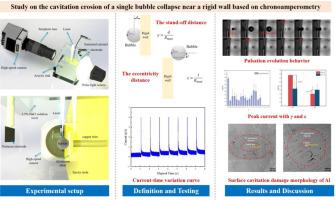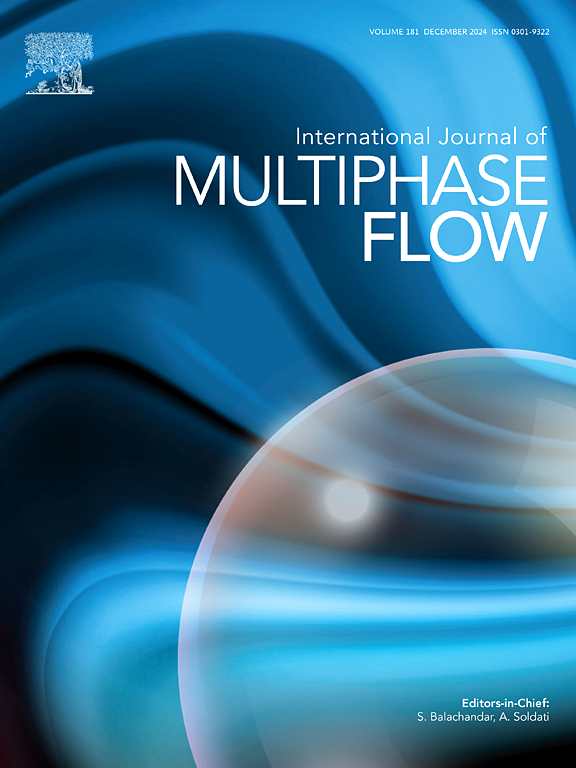基于计时电流法的刚性壁面单泡崩落空化侵蚀研究
IF 3.8
2区 工程技术
Q1 MECHANICS
International Journal of Multiphase Flow
Pub Date : 2025-08-05
DOI:10.1016/j.ijmultiphaseflow.2025.105394
引用次数: 0
摘要
空化确实是流体动力学中的一种重要现象,涉及液体中充满蒸汽的气泡的形成、增长和最终崩溃。这个过程会导致各种各样的影响,特别是当气泡在刚性壁上崩溃时,会导致空化侵蚀。在本研究中,研究了在刚性壁面附近单个空化气泡坍塌的动力学行为,重点研究了变化的无量纲气泡-壁面隔离距离(γ)和无量纲偏心距(ε)的影响。本研究通过高速摄影探索单个空化泡的脉动演化,利用计时电流法结合形态学分析表征空化侵蚀损伤。结果表明:(1)在空化泡与壁面的无因次距离γ = 0.1时,峰值电流达到最大值。这表明,在这一邻近地区,空化侵蚀最为严重。气泡第一次崩塌时产生的高速微射流和气泡第二次崩塌时环涡不对称崩塌时产生的破碎流都是空化侵蚀的原因,两者的破坏效果是相当的。(2)当无因次距离γ增加到1.3时,再次观测到严重的空化侵蚀,主要是由于环形涡的崩溃引起的。在这种情况下,微射流的贡献是最小的,这表明随着气泡远离壁面,侵蚀机制发生了变化。(3)在无因次距离为0.1时,材料表面呈现一个中心凹陷区,其特征是密集的凹坑呈环状分布。这反映了泡沫破裂对局部的强烈影响。在距离为1.3时,损伤形态有所不同,只有密集凹坑的环状分布,中心较平坦。这一变化表明,崩塌动力学和由此产生的射流相互作用随着距离的变化而显著变化。形态学观察结果与通过计时电流测定法确定的空化机制一致,强化了气泡动力学、侵蚀强度和由此产生的材料损伤之间的关系。本文章由计算机程序翻译,如有差异,请以英文原文为准。

Study on the cavitation erosion of a single bubble collapse near a rigid wall based on chronoamperometry
Cavitation is indeed a significant phenomenon in fluid dynamics, involving the formation, growth, and eventual collapse of vapor-filled bubbles in a liquid. This process can lead to various effects, particularly when bubbles collapse near a rigid wall, resulting in cavitation erosion. In this study, the dynamic behaviors of a single cavitation bubble collapsing near a rigid wall, focusing on varying dimensionless bubble-wall stand-off distances (γ) and the effects of dimensionless eccentricity (ε) were investigated. This study explored the pulsating evolution of a single cavitation bubble through high-speed photography, utilizing chronoamperometry combined with morphological analysis to characterize cavitation erosion damage. The results showed that: (1) At the dimensionless distance γ of 0.1 between the cavitation bubble and the wall, the peak current reached its maximum. This indicated that cavitation erosion was the most severe at this proximity. Both the high-velocity micro-jet generated during the first collapse of the bubble and the crushing flow generated during the asymmetric collapse of the ring vortex in the second collapse of the bubble contribute to cavitation erosion, with their damage effects being comparable. (2) When the dimensionless distance γ increased to 1.3, serious cavitation erosion was observed again, primarily caused by the collapse of the ring vortex. In this scenario, the contribution of micro-jets was minimal, indicating a shift in the erosion mechanism as the bubble was further from the wall. (3) At a dimensionless distance of 0.1, the material surface showed a centrally depressed area characterized by dense pits arranged in a ring-like distribution. This reflected the intense local impacts from the bubble collapse. At a distance of 1.3, the damage morphology was different, featuring only a ring-like distribution of dense pits with a flatter center. This change suggested that the collapse dynamics and resulting jet interactions vary significantly with distance. The morphological observations aligned with the cavitation mechanisms identified through chronoamperometry, reinforcing the relationship between bubble dynamics, erosion intensity, and the resultant material damage.
求助全文
通过发布文献求助,成功后即可免费获取论文全文。
去求助
来源期刊
CiteScore
7.30
自引率
10.50%
发文量
244
审稿时长
4 months
期刊介绍:
The International Journal of Multiphase Flow publishes analytical, numerical and experimental articles of lasting interest. The scope of the journal includes all aspects of mass, momentum and energy exchange phenomena among different phases such as occur in disperse flows, gas–liquid and liquid–liquid flows, flows in porous media, boiling, granular flows and others.
The journal publishes full papers, brief communications and conference announcements.

 求助内容:
求助内容: 应助结果提醒方式:
应助结果提醒方式:


